Editor’s note: The following is extracted from Hunting the Grizzly and Other Sketches, by Theodore Roosevelt (published 1889)
The wolf is the arch type of ravin, the beast of waste and desolation. It is still found scattered thinly throughout all the wilder portions of the United States, but has everywhere retreated from the advance of civilization.
Wolves show an infinite variety in color, size, physical formation, and temper. Almost all the varieties intergrade with one another, however, so that it is very difficult to draw a hard and fast line between any two of them. Nevertheless, west of the Mississippi there are found two distinct types. One is the wolf proper, or big wolf, specifically akin to the wolves of the eastern States. The other is the little coyote, or prairie wolf. The coyote and the big wolf are found together in almost all the wilder districts from the Rio Grande to the valleys of the upper Missouri and the upper Columbia. Throughout this region there is always a sharp line of demarkation, especially in size, between the coyotes and the big wolves of any given district; but in certain districts the big wolves are very much larger than their brethren in other districts. In the upper Columbia country, for instance, they are very large; along the Rio Grande they are small. Dr. Hart Merriam informs me that, according to his experience, the coyote is largest in southern California. In many respects the coyote differs altogether in habits from its big relative. For one thing it is far more tolerant of man. In some localities coyotes are more numerous around settlements, and even in the close vicinity of large towns, than they are in the frowning and desolate fastnesses haunted by their grim elder brother.
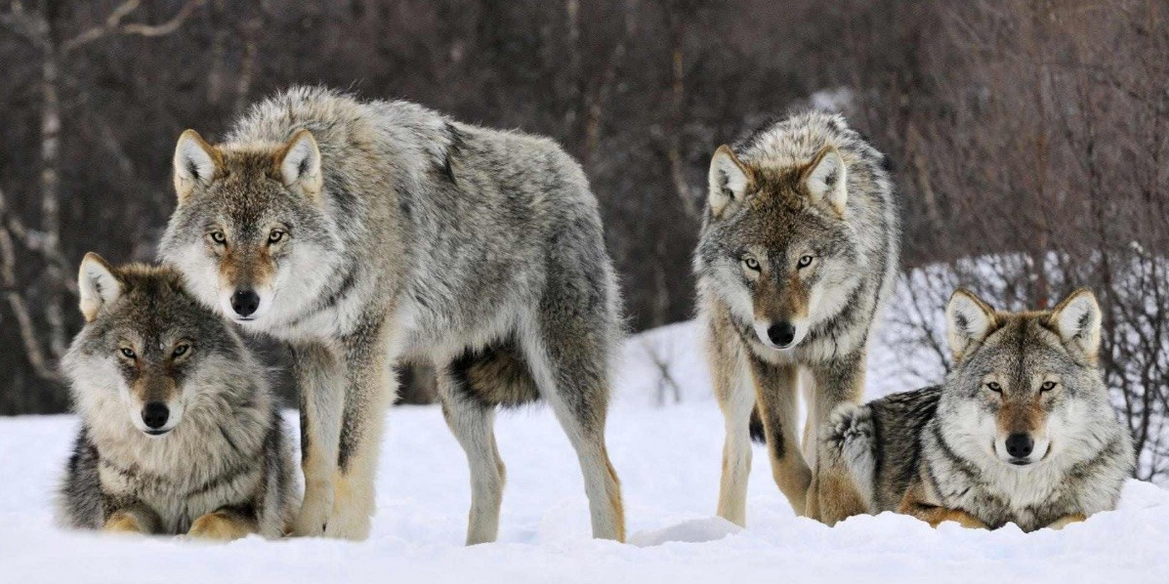
Big wolves vary far more in color than the coyotes do. I have seen white, black, red, yellow, brown, gray, and grizzled skins, and others representing every shade between, although usually each locality has its prevailing tint. The grizzled, gray, and brown often have precisely the coat of the coyote. The difference in size among wolves of different localities, and even of the same locality, is quite remarkable, and so, curiously enough, is the difference in the size of the teeth, in some cases even when the body of one wolf is as big as that of another. I have seen wolves from Texas and New Mexico which were undersized, slim animals with rather small tusks, in no way to be compared to the long-toothed giants of their race that dwell in the heavily timbered mountains of the Northwest and in the far North. As a rule, the teeth of the coyote are relatively smaller than those of the gray wolf.
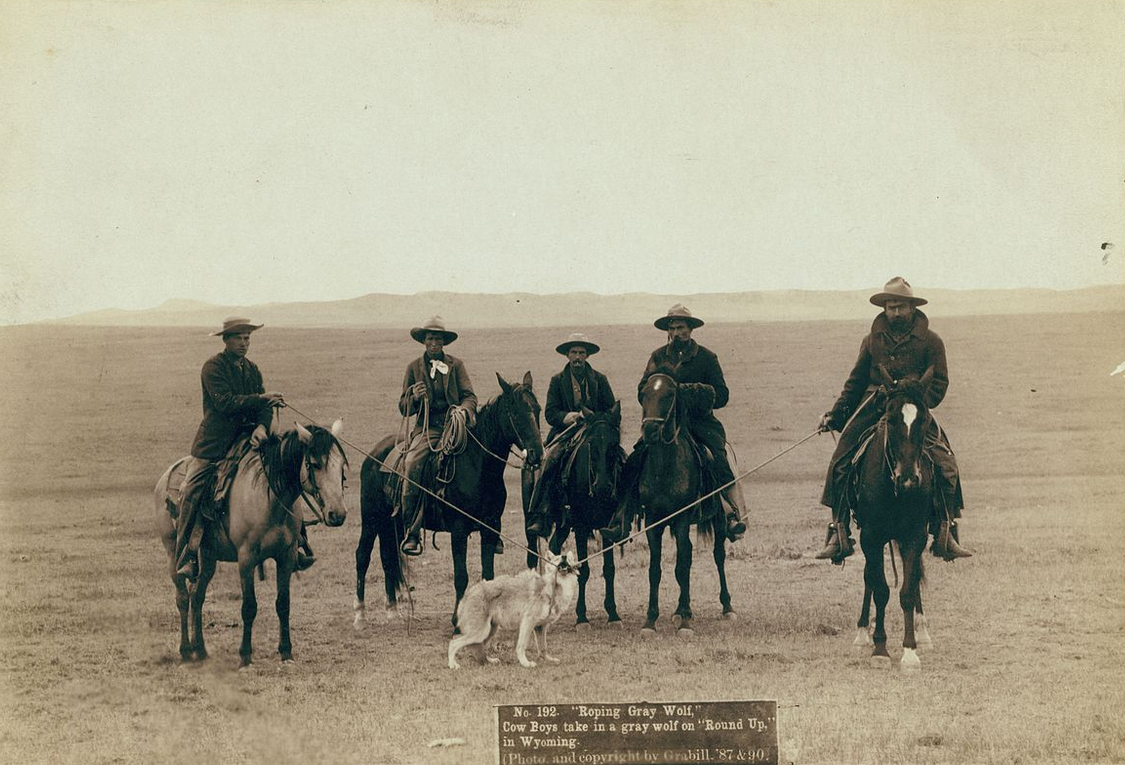
Formerly wolves were incredibly abundant in certain parts of the country, notably on the great plains, where they were known as buffalo wolves, and were regular attendants on the great herds of the bison. Every traveller and hunter of the old days knew them as among the most common sights of the plains, and they followed the hunting parties and emigrant trains for the sake of the scraps left in camp. Now, however, there is no district in which they are really abundant. The wolfers, or professional wolf-hunters, who killed them by poisoning for the sake of their fur, and the cattlemen, who likewise killed them by poisoning because of their raids on the herds, have doubtless been the chief instruments in working their decimation on the plains. In the ’70’s, and even in the early ’80’s, many tens of thousands of wolves were killed by the wolfers in Montana and northern Wyoming and western Dakota. Nowadays the surviving wolves of the plains have learned caution; they no longer move abroad at midday, and still less do they dream of hanging on the footsteps of hunter and traveler. Instead of being one of the most common they have become one of the rarest sights of the plains. A hunter may wander far and wide through the plains for months nowadays and never see a wolf, though he will probably see many coyotes. However, the diminution goes on, not steadily but by fits and starts, and moreover, the beasts now and then change their abodes, and appear in numbers in places where they have been scarce for a long period. In the present winter of 1892-’93 big wolves are more plentiful in the neighborhood of my ranch than they have been for ten years, and have worked some havoc among the cattle and young horses. The cowboys have been carrying on the usual vindictive campaign against them; a number have been poisoned, and a number of others have fallen victims to their greediness, the cowboys surprising them when gorged to repletion on the carcass of a colt or calf, and, in consequence, unable to run, so that they are easily ridden down, roped, and then dragged to death.
Yet even the slaughter wrought by man in certain localities does not seem adequate to explain the scarcity or extinction of wolves, throughout the country at large. In most places they are not followed any more eagerly than are the other large beasts of prey, and they are usually followed with less success. Of all animals the wolf is the shyest and hardest to slay. It is almost or quite as difficult to still-hunt as the cougar, and is far more difficult to kill with hounds, traps, or poison; yet it scarcely holds its own as well as the great cat, and it does not begin to hold its own as well as the bear, a beast certainly never more readily killed, and one which produces fewer young at a birth. Throughout the East the black bear is common in many localities from which the wolf has vanished completely. It at present exists in very scanty numbers in northern Maine and the Adirondacks; is almost or quite extinct in Pennsylvania; lingers here and there in the mountains from West Virginia to east Tennessee, and is found in Florida; but is everywhere less abundant than the bear. It is possible that this destruction of the wolves is due to some disease among them, perhaps to hydrophobia, a terrible malady from which it is known that they suffer greatly at times. Perhaps the bear is helped by its habit of hibernating, which frees it from most dangers during winter; but this cannot be the complete explanation, for in the South it does not hibernate, and yet holds its own as well as in the North. What makes it all the more curious that the American wolf should disappear sooner than the bear is that the reverse is the case with the allied species of Europe, where the bear is much sooner killed out of the land.
Indeed the differences of this sort between nearly related animals are literally inexplicable. Much of the difference in temperament between such closely allied species as the American and European bears and wolves is doubtless due to their surroundings and to the instincts they have inherited through many generations; but for much of the variation it is not possible to offer any explanation. In the same way there are certain physical differences for which it is very hard to account, as the same conditions seem to operate in directly reverse ways with different animals. No one can explain the process of natural selection which has resulted in the otter of America being larger than the otter of Europe, while the badger is smaller; in the mink being with us a much stouter animal than its Scandinavian and Russian kinsman, while the reverse is true of our sable or pine marten. No one can say why the European red deer should be a pigmy compared to its giant brother, the American wapiti; why the Old World elk should average smaller in size than the almost indistinguishable New World moose; and yet the bison of Lithuania and the Caucasus be on the whole larger and more formidable than its American cousin. In the same way no one can tell why under like conditions some game, such as the white goat and the spruce grouse, should be tamer than other closely allied species, like the mountain sheep and ruffled grouse. No one can say why on the whole the wolf of Scandinavia and northern Russia should be larger and more dangerous than the average wolf of the Rocky Mountains, while between the bears of the same regions the comparison must be exactly reversed.
The difference even among the wolves of different sections of our own country is very notable. It may be true that the species as a whole is rather weaker and less ferocious than the European wolf; but it is certainly not true of the wolves of certain localities. The great timber wolf of the central and northern chains of the Rockies and coast ranges is in every way a more formidable creature than the buffalo wolf of the plains, although they intergrade. The skins and skulls of the wolves of north-western Montana and Washington which I have seen were quite as large and showed quite as stout claws and teeth as the skins and skulls of Russian and Scandinavian wolves, and I believe that these great timber wolves are in every way as formidable as their Old World kinsfolk. However, they live where they come in contact with a population of rifle-bearing frontier hunters, who are very different from European peasants or Asiatic tribesmen; and they have, even when most hungry, a wholesome dread of human beings. Yet I doubt if an unarmed man would be entirely safe should he, while alone in the forest in mid-winter encounter a fair-sized pack of ravenously hungry timber wolves.
A full-grown dog-wolf of the northern Rockies, in exceptional instances, reaches a height of thirty-two inches and a weight of 130 pounds; a big buffalo wolf of the upper Missouri stands thirty or thirty-one inches at the shoulder and weighs about 110 pounds. A Texas wolf may not reach over eighty pounds. The bitch-wolves are smaller; and moreover there is often great variation even in the wolves of closely neighboring localities.
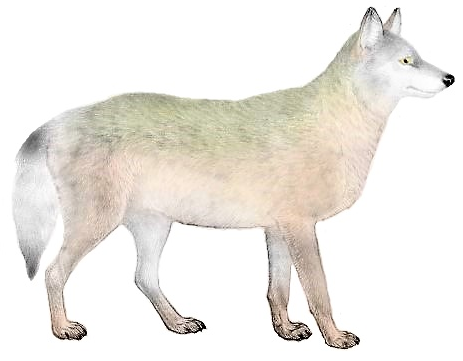
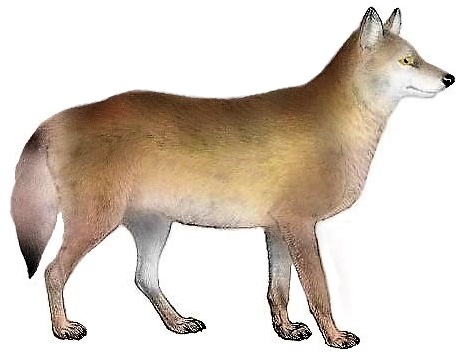
The wolves of the southern plains were not often formidable to large animals, even in the days when they most abounded. They rarely attacked the horses of the hunter, and indeed were but little regarded by these experienced animals. They were much more likely to gnaw off the lariat with which the horse was tied, than to try to molest the steed himself. They preferred to prey on young animals, or on the weak and disabled. They rarely molested a full-grown cow or steer, still less a full-grown buffalo, and, if they did attack such an animal, it was only when emboldened by numbers. In the plains of the upper Missouri and Saskatchewan the wolf was, and is, more dangerous, while in the northern Rockies his courage and ferocity attain their highest pitch. Near my own ranch the wolves have sometimes committed great depredations on cattle, but they seem to have queer freaks of slaughter. Usually they prey only upon calves and sickly animals; but in midwinter I have known one single-handed to attack and kill a well-grown steer or cow disabling its quarry by rapid snaps at the hams or flanks. Only rarely have I known it to seize by the throat. Colts are likewise a favorite prey, but with us wolves rarely attack full-grown horses. They are sometimes very bold in their assaults, falling on the stock while immediately around the ranch houses. They even venture into the hamlet of Medora itself at night—as the coyotes sometimes do by day. In the spring of ’92 we put on some eastern two-year-old steers; they arrived, and were turned loose from the stock-yards, in a snowstorm, though it was in early May. Next morning we found that one had been seized, slain, and partially devoured by a big wolf at the very gate of the stockyard; probably the beast had seen it standing near the yard after nightfall feeling miserable after its journey, in the storm and its unaccustomed surroundings, and had been emboldened to make the assault so near town by the evident helplessness of the prey.
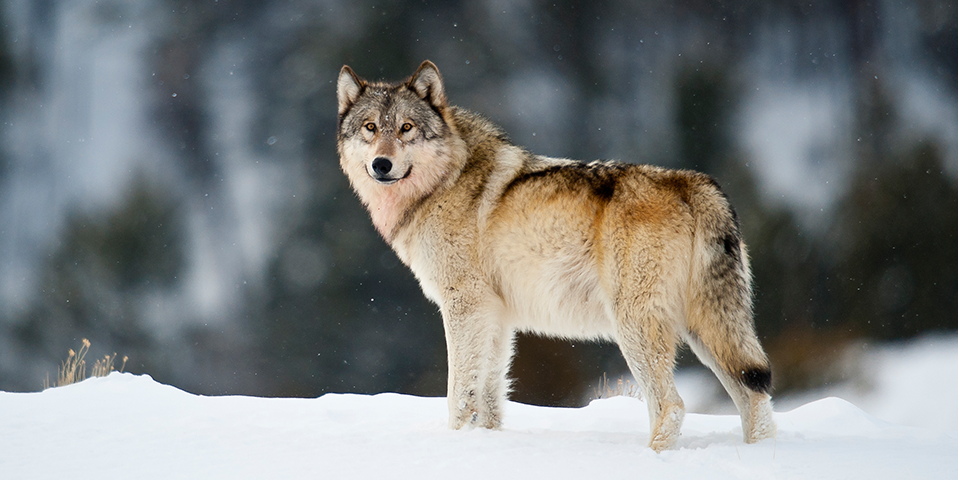
The big timber wolves of the northern Rocky Mountains attack every four-footed beast to be found where they live. They are far from contenting themselves with hunting deer and snapping up the pigs and sheep of the farm. When the weather gets cold and food scarce they band together in small parties, perhaps of four or five individuals, and then assail anything, even a bear or a panther. A bull elk or bull moose, when on its guard, makes a most dangerous fight; but a single wolf will frequently master the cow of either animal, as well as domestic cattle and horses. In attacking such large game, however, the wolves like to act in concert, one springing at the animal’s head, and attracting its attention, while the other hamstrings it. Nevertheless, one such big wolf will kill an ordinary horse. A man I knew, who was engaged in packing into the Coeur d’Alenes, once witnessed such a feat on the part of a wolf. He was taking his pack train down into a valley when he saw a horse grazing therein; it had been turned loose by another packing outfit, because it became exhausted. He lost sight of it as the trail went down a zigzag, and while it was thus out of sight he suddenly heard it utter the appalling scream, unlike and more dreadful than any other sound, which a horse only utters in extreme fright or agony. The scream was repeated, and as he came in sight again he saw that a great wolf had attacked the horse. The poor animal had been bitten terribly in its haunches and was cowering upon them, while the wolf stood and looked at it a few paces off. In a moment or two the horse partially recovered and made a desperate bound forward, starting at full gallop. Immediately the wolf was after it, overhauled it in three or four jumps, and then seized it by the hock, while its legs were extended, with such violence as to bring it completely back on its haunches. It again screamed piteously; and this time with a few savage snaps the wolf hamstrung and partially disemboweled it, and it fell over, having made no attempt to defend itself. I have heard of more than once incident of this kind. If a horse is a good fighter, however, as occasionally, though not often, happens, it is a more difficult prey for any wild beast, and some veteran horses have no fear of wolves whatsoever, well knowing that they can either strike them down with their forefeet or repulse them by lashing out behind.
Wolves are cunning beasts and will often try to lull their prey into unsuspicion by playing round and cutting capers. I once saw a young deer and a wolf-cub together near the hut of the settler who had captured both. The wolf was just old enough to begin to feel vicious and bloodthirsty, and to show symptoms of attacking the deer. On the occasion in question he got loose and ran towards it, but it turned, and began to hit him with its forefeet, seemingly in sport; whereat he rolled over on his back before it, and acted like a puppy at play. Soon it turned and walked off; immediately the wolf, with bristling hair, crawled after, and with a pounce seized it by the haunch, and would doubtless have murdered the bleating, struggling creature, had not the bystanders interfered.
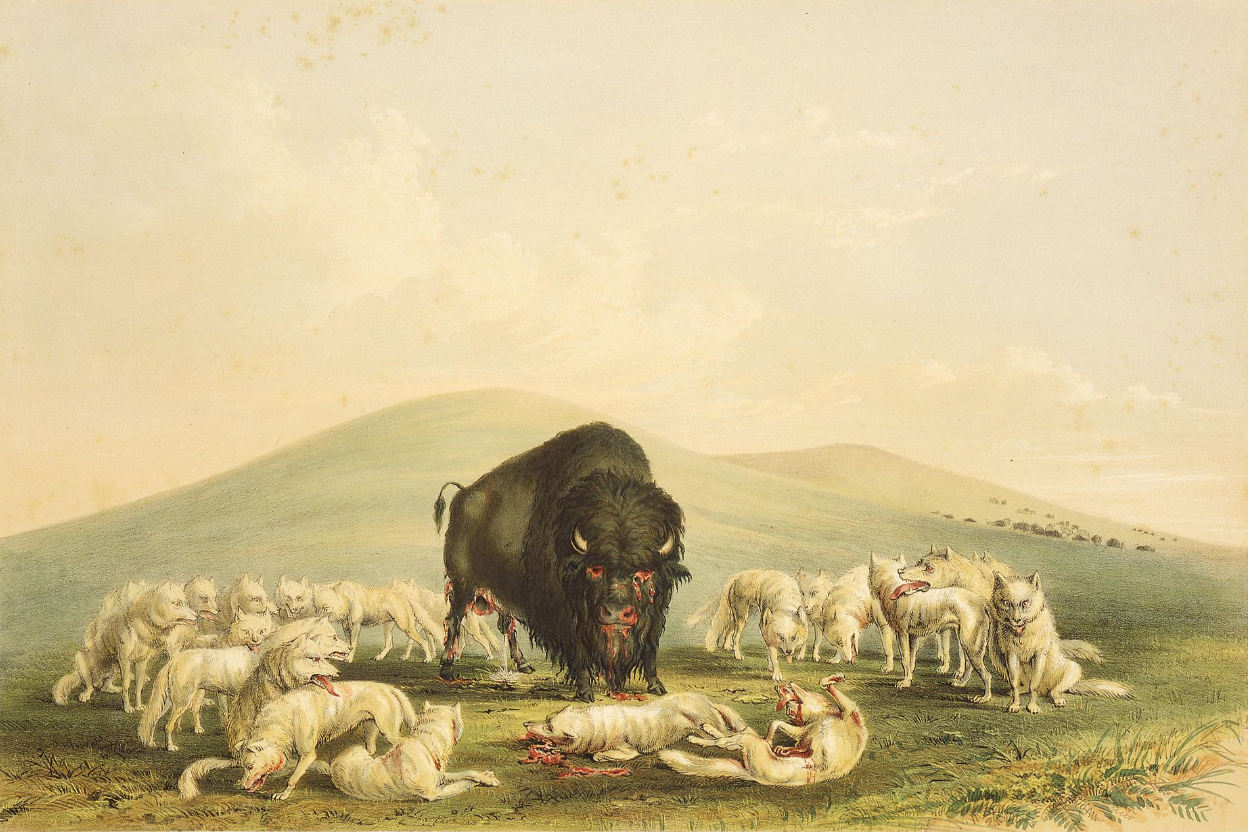
Where there are no domestic animals, wolves feed on almost anything from a mouse to an elk. They are redoubted enemies of foxes. They are easily able to overtake them in fair chase, and kill numbers. If the fox can get into the underbrush, however, he can dodge around much faster than the wolf, and so escape pursuit. Sometimes one wolf will try to put a fox out of a cover while another waits outside to snap him up. Moreover, the wolf kills even closer kinsfolk than the fox. When pressed by hunger it will undoubtedly sometimes seize a coyote, tear it in pieces and devour it, although during most of the year the two animals live in perfect harmony. I once myself, while out in the deep snow, came across the remains of a coyote that had been killed in this manner. Wolves are also very fond of the flesh of dogs, and if they get a chance promptly kill and eat any dog they can master—and there are but few that they cannot. Nevertheless, I have been told of one instance in which a wolf struck up an extraordinary friendship with a strayed dog, and the two lived and hunted together for many months, being frequently seen by the settlers of the locality. This occurred near Thompson’s Falls, Montana.
Usually wolves are found singly, in pairs, or in family parties, each having a large beat over which it regularly hunts, and also at times shifting its ground and travelling immense distances in order to take up a temporary abode in some new locality—for they are great wanderers. It is only under stress of severe weather that they band together in packs. They prefer to creep on their prey and seize it by a sudden pounce, but, unlike the cougar, they also run it down in fair chase. Their slouching, tireless gallop enables them often to overtake deer, antelope, or other quarry; though under favorable circumstances, especially if near a lake, the latter frequently escape. Whether wolves run cunning I do not know; but I think they must, for coyotes certainly do. A coyote cannot run down a jack-rabbit; but two or three working together will often catch one. Once I saw three start a jack, which ran right away from them; but they spread out, and followed. Pretty soon the jack turned slightly, and ran near one of the outside ones, saw it, became much frightened, and turned at right angles, so as soon to nearly run into the other outside one, which had kept straight on. This happened several times, and then the confused jack lay down under a sage-bush and was seized. So I have seen two coyotes attempting to get at a newly dropped antelope kid. One would make a feint of attack, and lure the dam into a rush at him, while the other stole round to get at the kid. The dam, as always with these spirited little prong-bucks, made a good fight, and kept the assailants at bay; yet I think they would have succeeded in the end, had I not interfered. Coyotes are bold and cunning in raiding the settler’s barn-yards for lambs and hens; and they have an especial liking for tame cats. If there are coyotes in the neighborhood a cat which gets into the habit of wandering from home is surely lost.
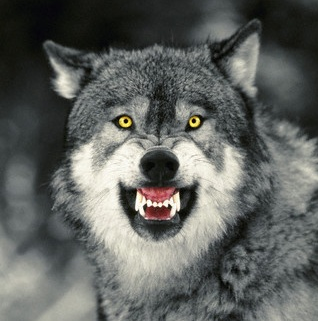
Though, I have never known wolves to attack a man, yet in the wilder portion of the far Northwest I have heard them come around camp very close, growling so savagely as to make one almost reluctant to leave the camp fire and go out into the darkness unarmed. Once I was camped in the fall near a lonely little lake in the mountains, by the edge of quite a broad stream. Soon after nightfall three or four wolves came around camp and kept me awake by their sinister and dismal howling. Two or three times they came so close to the fire that I could hear them snap their jaws and growl, and at one time I positively thought that they intended to try to get into camp, so excited were they by the smell of the fresh meat. After a while they stopped howling; and then all was silent for an hour or so. I let the fire go out and was turning into bed when I suddenly heard some animal of considerable size come down to the stream nearly opposite me and begin to splash across, first wading, then swimming. It was pitch dark and I could not possibly see, but I felt sure it was a wolf. However after coming half-way over it changed its mind and swam back to the opposite bank; nor did I see or hear anything more of the night marauders.
Five or six times on the plains or on my ranch I have had shots at wolves, always obtained by accident and always, I regret to say, missed. Often the wolf when seen was running at full speed for cover, or else was so far off that though motionless my shots went wide of it. But once have I with my own rifle killed a wolf, and this was while travelling with a pack train in the mountains. We had been making considerable noise, and I never understood how an animal so wary permitted our near approach. He did, nevertheless, and just as we came to a little stream which we were to ford I saw him get on a dead log some thirty yards distant and walk slowly off with his eyes turned toward us. The first shot smashed his shoulders and brought him down.

The wolf is one of the animals which can only be hunted successfully with dogs. Most dogs however do not take at all kindly to the pursuit. A wolf is a terrible fighter. He will decimate a pack of hounds by rabid snaps with his giant jaws while suffering little damage himself; nor are the ordinary big dogs, supposed to be fighting dogs, able to tackle him without special training. I have known one wolf to kill a bulldog which had rushed at it with a single snap, while another which had entered the yard of a Montana ranch house slew in quick succession both of the large mastiffs by which it was assailed. The immense agility and ferocity of the wild beast, the terrible snap of his long-toothed jaws, and the admirable training in which he always is, give him a great advantage over fat, small-toothed, smooth-skinned dogs, even though they are nominally supposed to belong to the fighting classes. In the way that bench competitions are arranged nowadays this is but natural, as there is no temptation to produce a worthy class of fighting dog when the rewards are given upon technical points wholly unconnected with the dog’s usefulness. A prize-winning mastiff or bulldog may be almost useless for the only purposes for which his kind is ever useful at all. A mastiff, if properly trained and of sufficient size, might possibly be able to meet a young or undersized Texas wolf; but I have never seen a dog of this variety which I would esteem a match single-handed for one of the huge timber wolves of western Montana. Even if the dog was the heavier of the two, his teeth and claws would be very much smaller and weaker and his hide less tough. Indeed I have known of but one dog which single-handed encountered and slew a wolf; this was the large vicious mongrel whose feats are recorded in my Hunting Trips of a Ranchman.
General Marcy of the United States Army informed me that he once chased a huge wolf which had gotten away with a small trap on its foot. It was, I believe, in Wisconsin, and he had twenty or thirty hounds with him, but they were entirely untrained in wolf-hunting, and proved unable to stop the crippled beast. Few of them would attack it at all, and those that did went at it singly and with a certain hesitation, and so each in turn was disabled by a single terrible snap, and left bleeding on the snow. General Wade Hampton tells me that in the course of his fifty years’ hunting with horse and hound in Mississippi, he has on several occasions tried his pack of fox-hounds (southern deer-hounds) after a wolf. He found that it was with the greatest difficulty, however, that he could persuade them to so much as follow the trail. Usually, as soon as they came across it, they would growl, bristle up, and then retreat with their tails between their legs. But one of his dogs ever really tried to master a wolf by itself, and this one paid for its temerity with its life; for while running a wolf in a canebrake the beast turned and tore it to pieces. Finally General Hampton succeeded in getting a number of his hounds so they would at any rate follow the trail in full cry, and thus drive the wolf out of the thicket, and give a chance to the hunter to get a shot. In this way he killed two or three.
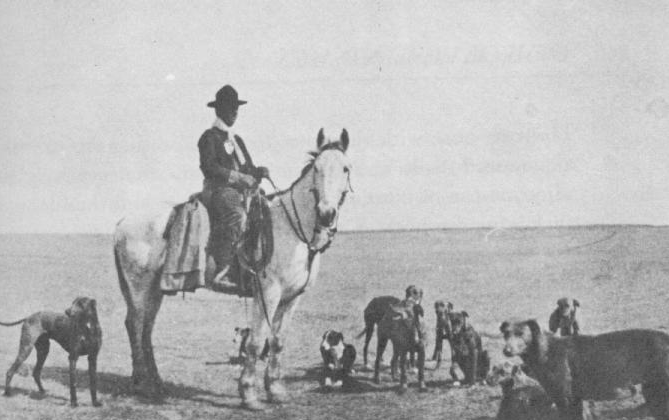
The true way to kill wolves, however, is to hunt them with greyhounds on the great plains. Nothing more exciting than this sport can possibly be imagined. It is not always necessary that the greyhounds should be of absolutely pure blood. Prize-winning dogs of high pedigree often prove useless for the purposes. If by careful choice, however, a ranchman can get together a pack composed both of the smooth-haired greyhound and the rough-haired Scotch deer-hound, he can have excellent sport. The greyhounds sometimes do best if they have a slight cross of bulldog in their veins; but this is not necessary. If once a greyhound can be fairly entered to the sport and acquires confidence, then its wonderful agility, its sinewy strength and speed, and the terrible snap with which its jaws come together, render it a most formidable assailant. Nothing can possibly exceed the gallantry with which good greyhounds, when their blood is up, fling themselves on a wolf or any other foe. There does not exist, and there never has existed on the wide earth, a more perfect type of dauntless courage than such a hound. Not Cushing when he steered his little launch through the black night against the great ram Albemarle, not Custer dashing into the valley of the Rosebud to die with all his men, not Farragut himself lashed in the rigging of the Hartford as she forged past the forts to encounter her iron-clad foe, can stand as a more perfect type of dauntless valor.
Once I had the good fortune to witness a very exciting hunt of this character among the foot-hills of the northern Rockies. I was staying at the house of a friendly cowman, whom I will call Judge Yancy Stump. Judge Yancy Stump was a Democrat who, as he phrased it, had fought for his Democracy; that is, he had been in the Confederate Army. He was at daggers drawn with his nearest neighbor, a cross-grained mountain farmer, who may be known as old man Prindle. Old man Prindle had been in the Union Army, and his Republicanism was of the blackest and most uncompromising type. There was one point, however, on which the two came together. They were exceedingly fond of hunting with hounds. The Judge had three or four track-hounds, and four of which he called swift-hounds, the latter including one pure-bred greyhound bitch of wonderful speed and temper, a dun-colored yelping animal which was a cross between a greyhound and a fox-hound, and two others that were crosses between a greyhound and a wire-haired Scotch deer-hound. Old man Prindle’s contribution to the pack consisted of two immense brindled mongrels of great strength and ferocious temper. They were unlike any dogs I have ever seen in this country. Their mother herself was a cross between a bull mastiff and a Newfoundland, while the father was descried as being a big dog that belonged to a “Dutch Count.” The “Dutch Count” was an outcast German noble, who had drifted to the West, and, after failing in the mines and failing in the cattle country, had died in a squalid log shanty while striving to eke out an existence as a hunter among the foot-hills. His dog, I presume, from the description given me, must have been a boar-hound or Ulm dog.
As I was very anxious to see a wolf-hunt the Judge volunteered to get one up, and asked old man Prindle to assist, for the sake of his two big fighting dogs; though the very names of the latter, General Grant and Old Abe, were gall and wormwood to the unreconstructed soul of the Judge. Still they were the only dogs anywhere around capable of tackling a savage timber wolf, and without their aid the judge’s own high-spirited animals ran a serious risk of injury, for they were altogether too game to let any beast escape without a struggle.
Luck favored us. Two wolves had killed a calf and dragged it into a long patch of dense brush where there was a little spring, the whole furnishing admirable cover for any wild beast. Early in the morning we started on horseback for this bit of cover, which was some three miles off. The party consisted of the Judge, old man Prindle, a cowboy, myself, and the dogs. The judge and I carried our rifles and the cowboy his revolver, but old man Prindle had nothing but a heavy whip, for he swore, with many oaths, that no one should interfere with his big dogs, for by themselves they would surely “make the wolf feel sicker than a stuck hog.” Our shaggy ponies racked along at a five-mile gait over the dewy prairie grass. The two big dogs trotted behind their master, grim and ferocious. The track-hounds were tied in couples, and the beautiful greyhounds loped lightly and gracefully alongside the horses. The country was fine. A mile to our right a small plains river wound in long curves between banks fringed with cottonwoods. Two or three miles to our left the foot-hills rose sheer and bare, with clumps of black pine and cedar in their gorges. We rode over gently rolling prairie, with here and there patches of brush in the bottoms of the slopes around the dry watercourses.
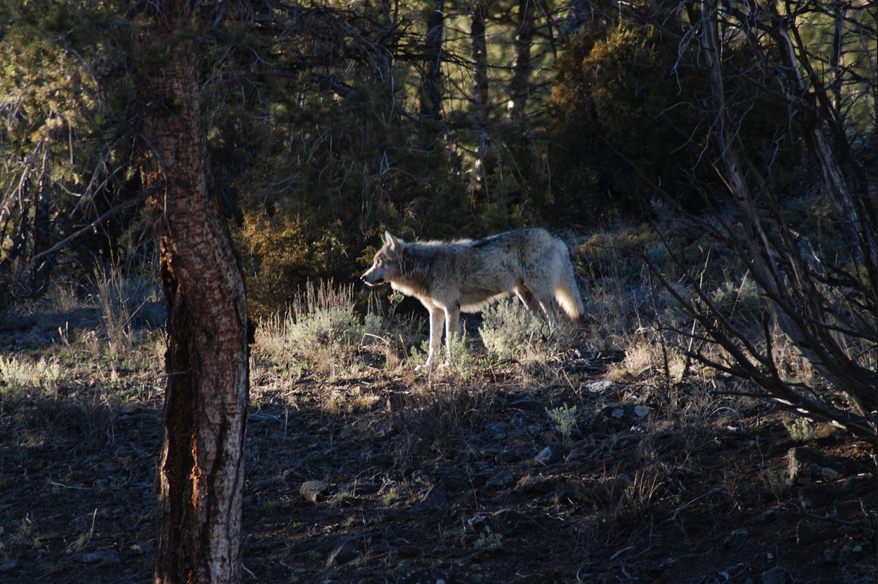
At last we reached a somewhat deeper valley in which the wolves were harbored. Wolves lie close in the daytime and will not leave cover if they can help it; and as they had both food and water within we knew it was most unlikely that this couple would be gone. The valley was a couple of hundred yards broad and three or four times as long, filled with a growth of ash and dwarf elm and cedar, thorny underbrush choking the spaces between. Posting the cowboy, to whom he gave his rifle, with two greyhounds on one side of the upper end, and old man Prindle with two others on the opposite side, while I was left at the lower end to guard against the possibility of the wolves breaking back, the Judge himself rode into the thicket near me and loosened the track-hounds to let them find the wolves’ trail. The big dogs also were uncoupled and allowed to go in with the hounds. Their power of scent was very poor, but they were sure to be guided aright by the baying of the hounds, and their presence would give confidence to the latter and make them ready to rout the wolves out of the thicket, which they would probably have shrunk from doing alone. There was a moment’s pause of expectation after the Judge entered the thicket with his hounds. We sat motionless on our horses, eagerly looking through the keen fresh morning air. Then a clamorous baying from the thicket in which both the horseman and dogs had disappeared showed that the hounds had struck the trail of their quarry and were running on a hot scent. For a couple of minutes we could not be quite certain which way the game was going to break. The hounds ran zigzag through the brush, as we could tell by their baying, and once some yelping and a great row showed that they had come rather closer than they had expected upon at least one of the wolves.
In another minute, however, the latter found it too hot for them and bolted from the thicket. My first notice of this was seeing the cowboy, who was standing by the side of his horse, suddenly throw up his rifle and fire, while the greyhounds who had been springing high in the air, half maddened by the clamor in the thicket below, for a moment dashed off the wrong way, confused by the report of the gun. I rode for all I was worth to where the cowboy stood, and instantly caught a glimpse of two wolves, grizzled-gray and brown, which having been turned by his shot had started straight over the hill across the plain toward the mountains three miles away. As soon as I saw them I saw also that the rearmost of the couple had been hit somewhere in the body and was lagging behind, the blood running from its flanks, while the two greyhounds were racing after it; and at the same moment the track-hounds and the big dogs burst out of the thicket, yelling savagely as they struck the bloody trail. The wolf was hard hit, and staggered as he ran. He did not have a hundred yards’ start of the dogs, and in less than a minute one of the greyhounds ranged up and passed him with a savage snap that brought him too; and before he could recover the whole pack rushed at him. Weakened as he was he could make no effective fight against so many foes, and indeed had a chance for but one or two rapid snaps before he was thrown down and completely covered by the bodies of his enemies. Yet with one of these snaps he did damage, as a shrill yell told, and in a second an over-rash track-hound came out of the struggle with a deep gash across his shoulders. The worrying, growling, and snarling were terrific, but in a minute the heaving mass grew motionless and the dogs drew off, save one or two that still continued to worry the dead wolf as it lay stark and stiff with glazed eyes and rumpled fur.
No sooner were we satisfied that it was dead than the Judge, with cheers and oaths and crackings of his whip, urged the dogs after the other wolf. The two greyhounds that had been with old man Prindle had fortunately not been able to see the wolves when they first broke from the cover, and never saw the wounded wolf at all, starting off at full speed after the unwounded one the instant he topped the crest of the hill. He had taken advantage of a slight hollow and turned, and now the chase was crossing us half a mile away. With whip and spur we flew towards them, our two greyhounds stretching out in front and leaving us as if we were standing still, the track-hounds and big dogs running after them just ahead of the horses. Fortunately the wolf plunged for a moment into a little brushy hollow and again doubled back, and this gave us a chance to see the end of the chase from nearby. The two greyhounds which had first taken up the pursuit were then but a short distance behind. Nearer they crept until they were within ten yards, and then with a tremendous race the little bitch ran past him and inflicted a vicious bite in the big beast’s ham. He whirled around like a top and his jaws clashed like those of a sprung bear-trap, but quick though he was she was quicker and just cleared his savage rush. In another moment he resumed his flight at full speed, a speed which only that of the greyhounds exceeded; but almost immediately the second greyhound ranged alongside, and though he was not able to bite, because the wolf kept running with its head turned around threatening him, yet by his feints he delayed the beast’s flight so that in a moment or two the remaining couple of swift hounds arrived on the scene. For a moment the wolf and all four dogs galloped along in a bunch; then one of the greyhounds, watching his chance, pinned the beast cleverly by the hock and threw him completely over. The others jumped on it in an instant; but rising by main strength the wolf shook himself free, catching one dog by the ear and tearing it half off. Then he sat down on his haunches and the greyhounds ranged themselves around him some twenty yards off, forming a ring which forbade his retreat, though they themselves did not dare touch him. However the end was at hand. In another moment Old Abe and General Grant came running up at headlong speed and smashed into the wolf like a couple of battering-rams. He rose on his hind-legs like a wrestler as they came at him, the greyhounds also rising and bouncing up and down like rubber balls. I could just see the wolf and the first big dog locked together, as the second one made good his throat-hold. In another moment over all three tumbled, while the greyhounds and one or two of the track-hounds jumped in to take part in the killing. The big dogs more than occupied the wolf’s attention and took all the punishing, while in a trice one of the greyhounds, having seized him by the hind-leg, stretched him out, and the others were biting his undefended belly. The snarling and yelling of the worry made a noise so fiendish that it was fairly bloodcurdling; then it gradually died down, and the second wolf lay limp on the plains, killed by the dogs, unassisted. This wolf was rather heavier and decidedly taller than either of the big dogs, with more sinewy feet and longer fangs.
I have several times seen wolves run down and stopped by greyhounds after a break-neck gallop and a wildly exciting finish, but this was the only occasion on which I ever saw the dogs kill a big, full-grown he-wolf unaided. Nevertheless various friends of mine own packs that have performed the feat again and again. One pack, formerly kept at Fort Benton, until wolves in that neighborhood became scarce, had nearly seventy-five to its credit, most of them killed without any assistance from the hunter; killed moreover by the greyhounds alone, there being no other dogs with the pack. These greyhounds were trained to the throat-hold, and did their own killing in fine style; usually six or eight were slipped together. General Miles informs me that he once had great fun in the Indian Territory hunting wolves with a pack of greyhounds. They had with the pack a large stub-tailed mongrel, of doubtful ancestry but most undoubted fighting capacity. When the wolf was started the greyhounds were sure to overtake it in a mile or two; they would then bring it to a halt and stand around it in a ring until the fighting dog came up. The latter promptly tumbled on the wolf, grabbing him anywhere, and often getting a terrific wound himself at the same time. As soon as he had seized the wolf and was rolling over with him in the grapple the other dogs joined in the fray and dispatched the quarry without much danger to themselves.
During the last decade many ranchmen in Colorado, Wyoming, and Montana, have developed packs of greyhounds able to kill a wolf unassisted. Greyhounds trained for this purpose always seize by the throat; and the light dogs used for coursing jack-rabbits are not of much service, smooth or rough-haired greyhounds and deer-hounds standing over thirty inches at the shoulder and weighing over ninety pounds being the only ones that, together with speed, courage, and endurance, possess the requisite power.
One of the most famous packs in the West was that of the Sun River Round Club, in Montana, started by the stockmen of Sun River to get rid of the curse of wolves which infested the neighborhood and worked very serious damage to the herds and flocks. The pack was composed of both greyhounds and deer-hounds, the best being from the kennels of Colonel Williams and of Mr. Van Hummel, of Denver; they were handled by an old plainsman and veteran wolf-hunter named Porter. In the season of ’86 the astonishing number of 146 wolves were killed with these dogs. Ordinarily, as soon as the dogs seized a wolf, and threw or held it, Porter rushed in and stabbed it with his hunting-knife; one day, when out with six hounds, he thus killed no less than twelve out of the fifteen wolves started, though one of the greyhounds was killed, and all the others were cut and exhausted. But often the wolves were killed without his aid. The first time the two biggest hounds—deer-hounds or wire-haired greyhounds—were tried, when they had been at the ranch only three days, they performed such a feat. A large wolf had killed and partially eaten a sheep in a corral close to the ranch house, and Porter started on the trail, and followed him at a jog-trot nearly ten miles before the hounds sighted him. Running but a few rods, he turned viciously to bay, and the two great greyhounds struck him like stones hurled from a catapult, throwing him as they fastened on his throat; they held him down and strangled him before he could rise, two other hounds getting up just in time to help at the end of the worry.
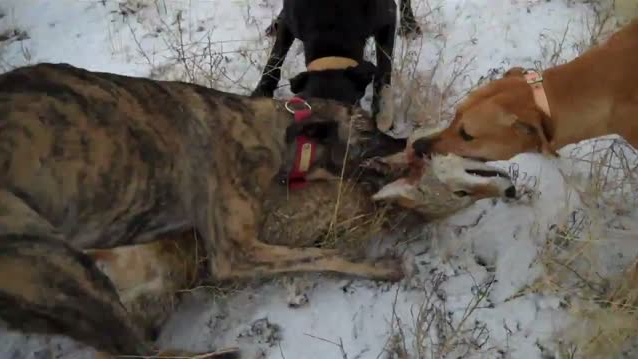
Ordinarily, however, no two greyhounds or deer-hounds are a match for a gray wolf, but I have known of several instances in Colorado, Wyoming, and Montana, in which three strong veterans have killed one. The feat can only be performed by big dogs of the highest courage, who all act together, rush in at top speed, and seize by the throat; for the strength of the quarry is such that otherwise he will shake off the dogs, and then speedily kill them by rabid snaps with his terribly armed jaws. Where possible, half a dozen dogs should be slipped at once, to minimize the risk of injury to the pack; unless this is done, and unless the hunter helps the dogs in the worry, accidents will be frequent, and an occasional wolf will be found able to beat off, maiming or killing, a lesser number of assailants. Some hunters prefer the smooth greyhound, because of its great speed, and others the wire-coated animal, the rough deer-hound, because of its superior strength; both, if of the right kind, are dauntless fighters.
Colonel Williams’ greyhounds have performed many noble feats in wolf-hunting. He spent the winter of 1875 in the Black Hills, which at that time did not contain a single settler, and fairly swarmed with game. Wolves were especially numerous and very bold and fierce, so that the dogs of the party were continually in jeopardy of their lives. On the other hand they took an ample vengeance, for many wolves were caught by the pack. Whenever possible, the horsemen kept close enough to take an immediate hand in the fight, if the quarry was a full-grown wolf, and thus save the dogs from the terrible punishment they were otherwise certain to receive. The dogs invariably throttled, rushing straight at the throat, but the wounds they themselves received were generally in the flank or belly; in several instances these wounds resulted fatally. Once or twice a wolf was caught, and held by two greyhounds until the horsemen came up but it took at least five dogs to overcome and slay unaided a big timber wolf. Several times the feat was performed by a party of five, consisting of two greyhounds, one rough-coated deer-hound, and two cross-bloods; and once by a litter of seven young greyhounds, not yet come to their full strength.
Once or twice the so-called Russian wolf-hounds or silky coated greyhounds, the “borzois,” have been imported and tried in wolf-hunting on the western plains; but hitherto they have not shown themselves equal, at either running or fighting, to the big American-bred greyhounds of the type produced by Colonel Williams and certain others of our best western breeders. Indeed I have never known any foreign greyhounds, whether Scotch, English, or from continental Europe, to perform such feats of courage, endurance, and strength, in chasing and killing dangerous game, as the homebred greyhounds of Colonel Williams.

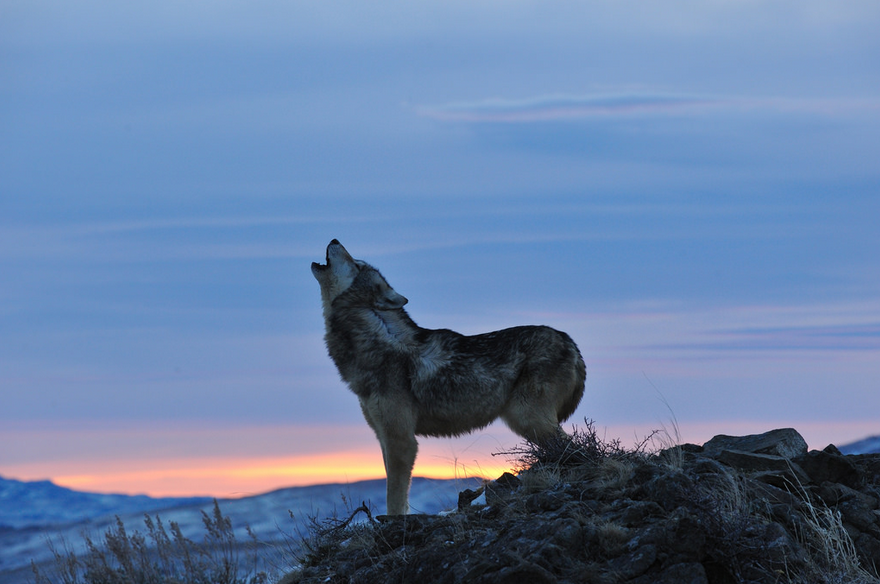





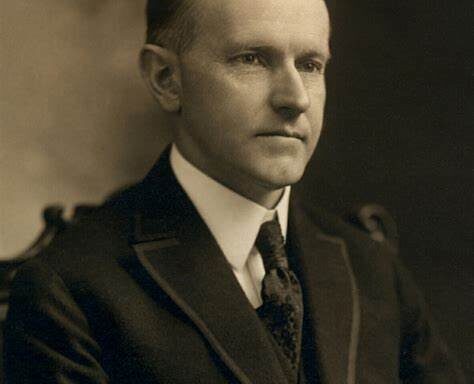

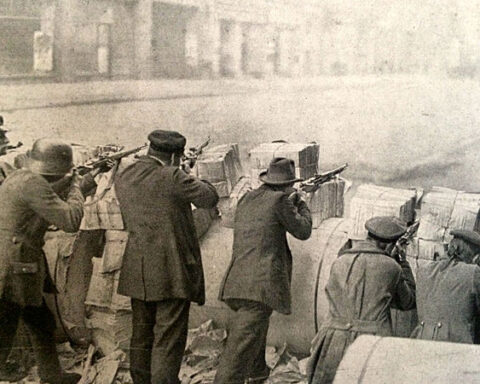
4.5
Thanks for posting this, I enjoyed reading it.
Coyotes are so numerous in Michigan that it’s open season year-round. Several years ago I saw one coming close to our chicken coop and like a thunderbolt realized that all had in the house was a .22 lr. Since then we have enhanced the inventory. Good thing too because since then I’ve seen a few that look like 3/4 scale models of wolves.
5
[…] (Men of the West): The following is extracted from Hunting the Grizzly and Other Sketches, by Theodore Roosevelt […]